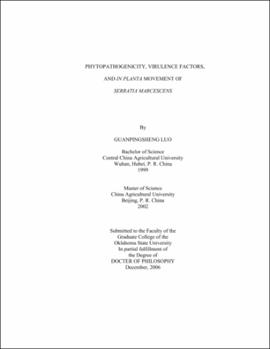| dc.contributor.advisor | Fletcher, Jacqueline | |
| dc.contributor.author | Luo, Guanpingsheng | |
| dc.date.accessioned | 2013-11-26T08:23:46Z | |
| dc.date.available | 2013-11-26T08:23:46Z | |
| dc.date.issued | 2006-12 | |
| dc.identifier.uri | https://hdl.handle.net/11244/6743 | |
| dc.description.abstract | Scope and Method of Study: | |
| dc.description.abstract | Serratia marcescens, the causal agent of cucurbit yellow vine disease (CYVD), can colonize in many niches, including soil, water, insects, plants and humans. It is unclear whether strains from one niche can colonize others and whether these bacteria can enter into plants through natural openings. Strains of S. marcescens have many pathogenicity and virulence factors including proteases, nucleases, cytotoxin, hemolysin, chitinase, siderophores, lipopolysaccharide and fimbriae. However, it is not known what virulence factor (s) phytopathogenic strains use for disease development in plants. | |
| dc.description.abstract | Findings and Conclusions: | |
| dc.description.abstract | In this research, different plant species were used to assess the pathogenicity of various strains of S. marcescens. Only CYVD- causing strains of S. marcescens caused stunting on squash. However, all the tested strains of S. marcescens, regardless of their natural niche, caused chlorotic lesions and necrosis on tobacco leaves, wilt on carrot seedlings and water-soaking and rotting of onion bulbs. This is the first report that S. marcescens strains from non-plant niches cause symptoms in plants, and that their interactions with the plant host differ from those of CYVD-strains. | |
| dc.description.abstract | The TargeTron Gene Knockout System was used to mutate the fimbrial genes fimA and fimH of S. marcescens ZO1-A. fimA mutation prevented fimbrial formation, while fimH mutation reduced fimbrial length. Both mutants significantly reduced virulence on squash plants. | |
| dc.description.abstract | GFP-labeled S. marcescens cells were introduced onto squash plants. Fluorescence and confocal microscopy showed no evidence that S. marcescens entered into the plant interior through the stomata after being dropped onto leaf surface. S. marcescens did move into the plant interior through stomata by vacuum infiltration, but bacterial cells remained in the vicinity of the stomata and did not enter the vascular system. After wound inoculation, GFP-S. marcescens cells were detected in intercellular spaces as well as within xylem vessels, and were present as much as 31 mm away from the inoculation site, suggesting that systemic translocation occurred. This is the first report of S. marcescens entry and movement within xylem. Our results indicate that the nature and location of S. marcescens colonization and translocation in squash plants are apparently dependent upon how and where the bacteria are inoculated. | |
| dc.format | application/pdf | |
| dc.language | en_US | |
| dc.rights | Copyright is held by the author who has granted the Oklahoma State University Library the non-exclusive right to share this material in its institutional repository. Contact Digital Library Services at lib-dls@okstate.edu or 405-744-9161 for the permission policy on the use, reproduction or distribution of this material. | |
| dc.title | Phytopathogenicity, virulence factors, and in planta movement of Serratia marcescens | |
| dc.contributor.committeeMember | Melcher, Ulrich | |
| dc.contributor.committeeMember | Bender, Carol L. | |
| dc.contributor.committeeMember | Wayadande, Astri Cassandra | |
| osu.filename | Luo_okstate_0664D_2140 | |
| osu.accesstype | Open Access | |
| dc.type.genre | Dissertation | |
| dc.type.material | Text | |
| thesis.degree.discipline | Entomology and Plant Pathology | |
| thesis.degree.grantor | Oklahoma State University | |
